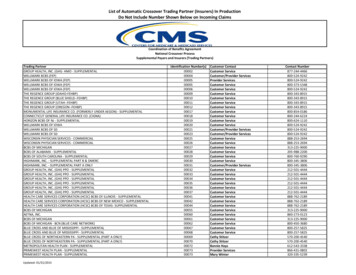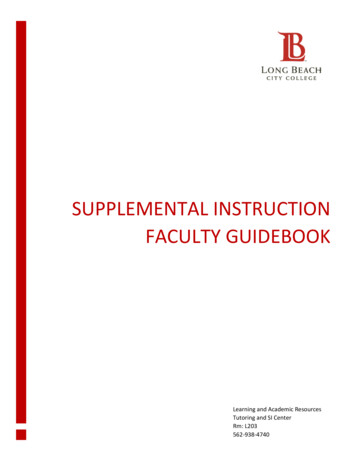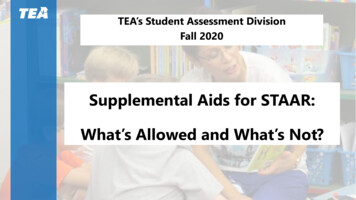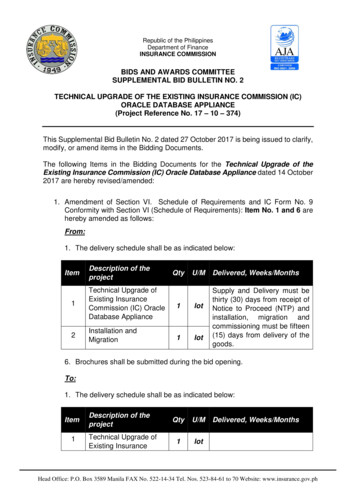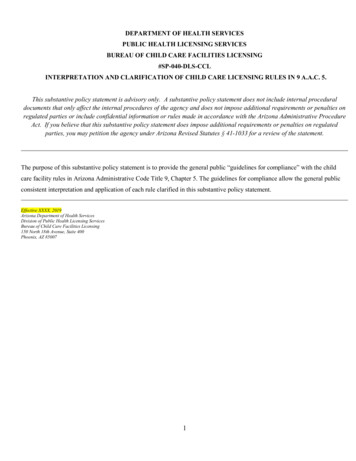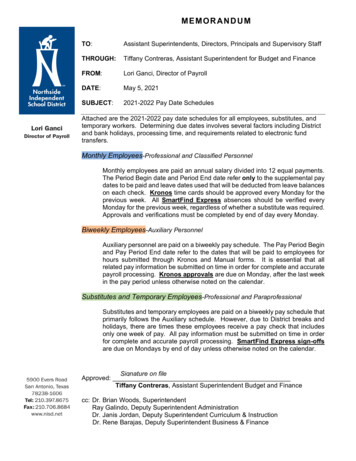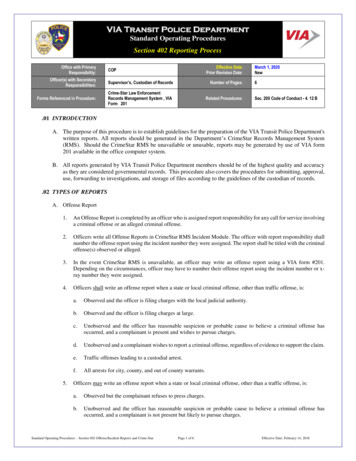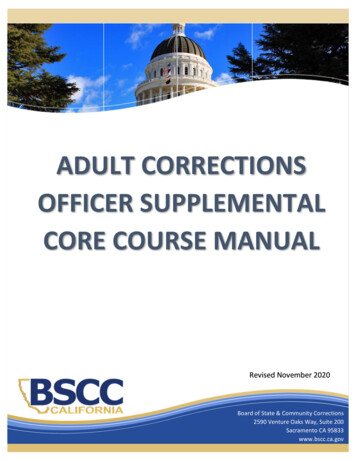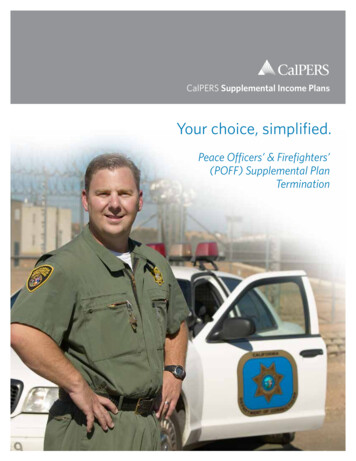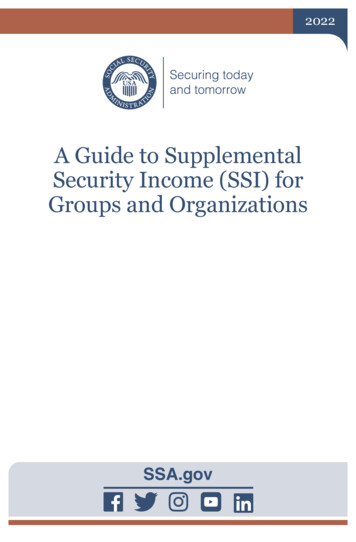
Transcription
2022A Guide to SupplementalSecurity Income (SSI) forGroups and OrganizationsSSA.gov
What’s insideA guide to Supplemental Security Income(SSI) for groups and organizations1About this booklet1How groups and organizations can help1SSI payments and state services4Who can get SSI?8Achieving a Better Life Experience(ABLE) Account20Information for people who getor apply for SSI21Helping people who get SSI go backto work26Quick benefit restart28Contacting Social Security28
A guide to Supplemental Security Income(SSI) for groups and organizationsSupplemental Security Income (SSI) is a federal programthat provides monthly payments to more than eight millionpeople who have limited income and few resources.SSI is for people who are 65 or older, as well as peopleof any age, including children, who are blind or havequalifying disabilities.About this bookletThis booklet explains the SSI program to institutions,groups, and organizations that have contact and helppeople who get, or may be able to get SSI.To get SSI, you must meet one of the following criteria: Are age 65 or older. Are totally or partially blind. Have a medical condition that keeps you from workingand is expected to last at least one year or resultin death.Social Security runs the SSI program. We also decidewho is eligible, pay benefits, and keep a record ofrecipients. Even though we run the program, U.S.Treasury general funds, not Social Security trust funds,provide funding for SSI.You can get general descriptions of the SSIprogram by reading Supplemental Security Income(SSI) (Publication No. 05-11000) and You May BeAble to Get Supplemental Security Income (SSI)(Publication No. 05-11069).1
How groups and organizations can helpYou can help us spread the word about SSI.As an organization’s representative, you can help peopleby providing them with transportation to interviews,helping them gather information needed to apply(see our “Applying for SSI” section), or by assistingthem with getting required medical evidence. You canalso help people complete part of their SSI disabilityapplication at www.ssa.gov/benefits/ssi if they meetcertain requirements. If they already receive SSI, andneed proof of their benefits, you can help them get aninstant benefit verification letter online with a personalmy Social Security account. More information is availableat www.ssa.gov/myaccount.Help people experiencing homelessnessSSI can help a person who is experiencing homelessnessget housing by providing monthly payments. Yet, aperson doesn’t need a home to get SSI. We can arrangeto give SSI payments to people who are experiencinghomelessness electronically. An organization canserve as a mail drop location, allowing a person who ishomeless to pick up important correspondence from us atthe organization’s address.Be a representative payeeSome people who get SSI are not able to manage theirbenefits. In these cases, a representative payee receivesthe SSI payments on their behalf. Representative payeesare responsible for using SSI payments to take care of thebasic needs of the recipient.Some organizations that serve as payee for five or morebeneficiaries can charge a fee if we authorize it. For2022, the allowed monthly fee is 10% of the monthlybenefit, up to a maximum of 48. For customers with adrug or alcohol addiction, the 2022 fee amount is 10% of2
the monthly benefit, up to a maximum of 89. For moreinformation about serving as a payee, read A Guide forRepresentative Payees (Publication No. 05-10076).Pre-release applicationsPeople can apply for SSI before being released froma public or private facility, such as a prison or mentalinstitution, to help ease their transition back into thecommunity. An institution may establish a pre-releaseagreement with us. This agreement allows us to workwith the institution to start the benefit application processseveral months before the person’s scheduled releasedate. This will allow those eligible to receive timely SSIpayments upon reentering the community.SSI payments while in an institutionInstitutions and organizations can help someone continuereceiving their SSI payments by telling us when theperson enters an institution. Most people who live in apublic institution can’t get a full SSI payment. See our“People in institutions” section for more information onthe rules for receiving SSI while in an institution.Help for low-income Medicare beneficiariesIf a person with limited income and resources is eligiblefor Medicare, the state may pay the Medicare Part Bpremiums and other out-of-pocket medical expensesthrough the Medicare Savings Programs. These expensesmay include deductibles, coinsurance, and copayments.For more information about Medicare Savings Programscontact the state medical assistance (Medicaid) office orthe State Health Insurance Assistance Program (SHIP).Limited-income Medicare beneficiaries may also beable to get Extra Help with Medicare prescription drugcosts. People may automatically get Extra Help to helppay for Medicare prescription drug premiums and otherout-of-pocket medical expenses (such as deductibles,3
coinsurance, and copayments) if they meet all theseconditions: They have full Medicaid coverage. The state pays Part B premiums. They get SSI.People who do not automatically get Extra Help mustenroll in a Medicare prescription drug plan and applyfor Extra Help. To apply for Extra Help online visit us atwww.ssa.gov/extrahelp. To apply for Extra Help over thephone or to request an application call 1-800-772-1213.TTY users can call 1-800-325-0778.SSI payments and state servicesHow we make paymentsPeople who apply for SSI must receive paymentselectronically. Electronic payments can be made by directdeposit, the Direct Express card program, or an ElectronicTransfer Account. Learn more at www.GoDirect.org.SSI payment ratesIn 2022, the highest federal SSI payment is 841 a monthfor a person, and 1,261 a month for a couple.The states of Arizona, Mississippi, North Dakota, andWest Virginia, as well as the Northern Mariana Islandsterritory don’t supplement the federal SSI payment.All other states and territories add money to federalSSI payments.Some states run their own programs and others let usmanage their state supplements.The state supplements administered by us, in total or inpart, are California, Delaware, Hawaii, Iowa, Michigan,Montana, Nevada, New Jersey, Pennsylvania, RhodeIsland, and Vermont. The same is true for the Districtof Columbia.4
If we manage the state’s supplemental payment, onecheck is paid to the recipient each month that combinesthe federal and state SSI payments.States may change the payment amounts based onwhere, and with whom, people live. Also, some statesmight not count other income.Maximum payment for individual/couple livingindependently (2022)StateOlderpersonBlindHas adisabilityCalifornia 1,040.21/ 1,765.64 1,110.26/ 1,952.88 1,040.21/ 1,765.64Delaware¹, ² 841/ 1,261 841/ 1,261 841/ 1,261Hawaii² 841/ 1,261 841/ 1,261 841/ 1,261Iowa¹, ² 841/ 1,261 863/ 1,305 841/ 1,261Michigan¹, ² 841/ 1,261 841/ 1,261 841/ 1,261Montana¹, ² 841/ 1,261 841/ 1,261 841/ 1,261Nevada 877.40/ 1,355.46 950.30/ 1,635.60 841/ 1,261New Jersey 872.25/ 1,286.35 872.25/ 1,286.35 872.25/ 1,286.35Pennsylvania¹, ² 841/ 1,261 841/ 1,261 841/ 1,261Rhode Island¹, ² 841/ 1,261 841/ 1,261 841/ 1,261Vermont 893.04/ 1,359.88 893.04/ 1,359.88 893.04/ 1,359.88Washington,D.C.¹, ² 841/ 1,261 841/ 1,261 841/ 1,2615
¹ Supplement run jointly by federal and state government.² State pays supplement only when recipient lives inparticular settings.How we figure payment amountsBefore we begin paying someone SSI, we’ll send therecipient a letter that details when payment will start andhow much it’ll be.We compute the first SSI payment from the first fullmonth after the person applied or became eligible forSSI. The amount paid may not be the same everymonth. The amount depends on other income and livingarrangements. We’ll tell the person in advance wheneverwe change the amount of the payment.The federal and state SSI payments may increase to keepup with the cost of living. Normally these increases comein January.When a person becomes eligible again after beingineligible, the payment sometimes is prorated from thedate the person became eligible to the end of the month.For example, a person who becomes eligible on the10th day of the month will get an SSI payment based onthe number of days from the 10th to the last day of themonth. The payment amount is first calculated accordingto the person’s income and living arrangements. Thenit’s prorated.We reduce the base SSI payment by one-third if a personor couple is living in another person’s home and gettingfood and shelter from that person. This reduction takesthe place of setting the exact dollar value for the help.Support is any food, shelter, or both that is given tosomeone or paid for by someone else.6
State servicesSome states may provide people who get SSI withMedicaid and other services.Interim assistance paymentsSome states and local subdivisions make “interimassistance payments” to people while they wait for adecision on whether they can get SSI. We will pay backthe state or local government from the person’s firstretroactive SSI payment.MedicaidIn most states, people who get SSI also get Medicaid,which pays health care expenses.In some states, Medicaid is available to a child with aqualifying disability, who is age 18 or younger, and whoreceives home care that costs the government less thaninstitutional care. If someone gives away or sells personalitems for less than what they are worth, or the person isa beneficiary of a trust, it may affect Medicaid coverage.For more information about Medicaid, contact the statemedical assistance (Medicaid) office or local health orhuman services office.Social servicesPeople who get SSI might be able to get social servicesfrom the state, city, or county. Depending on where theperson lives, these may include homemaker services, andarrangements for meals or transportation. Find out moreat the local health or human services office.7
Supplemental Nutrition Assistance Program (SNAP)People who get SSI may be able to get help to buy foodthrough the Supplemental Nutrition Assistance Program(SNAP), formerly known as food stamps. If everyone inyour household is applying for or receiving SSI, you canapply for SNAP at a one of our offices.People who don’t live in a household in whicheveryone is applying for or receiving SSI can visitwww.fns.usda.gov/snap to find out how to apply.For more information about SNAP, read SupplementalNutrition Assistance Program (SNAP) Facts(Publication No. 05-10101). For more informationabout other nutrition assistance programs that may beavailable to you, read Nutrition Assistance Programs(Publication No. 05-10100) available at www.ssa.gov.Who can get SSI?People with low income and few resources who are age65 or older, blind, or have a qualifying disability, maybe able to get SSI. See “Other rules” for additionalrequirements. We consider people age 18 or older to havea disability if they have a physical or mental condition (orcombination of conditions) that keeps them from working.The condition must be expected to last at least 12 monthsor result in death.We consider a child younger than age 18 to have adisability if the child has a physical or mental condition(or combination of conditions) that results in “markedand severe functional limitations.” The condition must beexpected to last at least 12 months or result in death. Formore information about benefits for children, read Benefitsfor Children With Disabilities (Publication No. 05-10026).8
We consider a person “blind” if they have vision no betterthan 20/200 or a limited visual field of 20 degrees or lessin the better eye with the use of eyeglasses. A personwhose sight isn’t poor enough to be “blind” may still beconsidered to have a qualifying disability.What is income?SSI considers “income” anything a person receives thatcan be used for food or shelter. Income includes but isn’tlimited to cash, checks, and “gift” items received, such asfood and shelter.SSI divides income into two categories — earned andunearned. Earned income includes wages, net earningsfrom self-employment, certain royalties and honoraria,and money from sheltered workshops. Unearned incomeincludes all income that a person doesn’t earn. Thisincludes Social Security benefits, workers’ compensation,certain veterans’ compensation or pension payments,unemployment, pensions, support and maintenance inkind, annuities, rent, and other income that isn’t earned.In 2022, a person must have less than 861 a month inunearned income to receive SSI. A couple can get SSI ifthey have unearned income of less than 1,281 a monthin 2022.Because a larger portion of earned income isn’t counted,a person who gets SSI can earn up to 1,767 a month( 2,607 for a couple) and still get SSI.Although we encourage people who already receive SSIto work, people who work while applying for SSI basedon a qualifying disability can’t make as much in earnedincome. That’s because their ability to work affects ourdisability decision. In 2022, a person applying for SSIdisability payments who isn’t blind, and who works andearns more than 1,350 a month, probably won’t be able9
to get SSI. A person who is blind, is just now applyingfor SSI disability payments, and earns 2,260 a monthprobably won’t be able to get SSI.People who live in a state that adds money to the federalpayment can get SSI even if they have more income (seethe chart under “SSI payment rates”).SSI payments are reduced for people with other income.Not everything a person gets is income and some thingsthat are income don’t count.What doesn’t count as income? Medical care and services (including reimbursementsand payment of health insurance premiums by others). Social services. Income from the sale, exchange, or replacement ofresources (these are considered resources). Income tax refunds. Insurance on charge accounts or other credit accounts. Proceeds of a bona fide loan. Bills paid by someone else for things other than foodor shelter. Replacement of lost or stolen income. Home (low income) energy assistance. Earned or unearned income of 20 a month (exceptsome types of unearned income based on need, suchas certain veterans’ pensions). Earned income of 65 a month plus one-half of earnedincome over 65 a month or, if there is no unearnedincome, 85 a month of earned income plus one-halfof the rest. Supplemental Nutrition Assistance Program (SNAP),formerly known as food stamp assistance.10
Government refunds of taxes paid on real property oron food purchases. Assistance based on need from a state or local politicalsubdivision or Indian tribe. Amounts for tuition and fees paid fromgrants, scholarships, fellowships, and gifts foreducational expenses. Home-grown produce consumed by the household. Irregular or infrequent earned income totaling no morethan 30 a quarter. Irregular or infrequent unearned income totaling nomore than 60 a quarter. Domestic commercial transportation tickets receivedas gifts and used. Payments for giving foster care to a child not gettingSSI, but placed by an approved agency in the home ofsomeone getting SSI. One-third of any child support payments from theabsent parent if you are a child. Earnings (up to 2,040 a month, but no more than 8,230 a year in 2022) of a person younger than age22 who regularly attends school or a training program. Grants or loans to students from the Departmentof Education’s or Bureau of Indian Affairs’educational programs. Income needed by a blind or person with a disabilityfor an approved plan to achieve self-support(see “Plan to Achieve Self-Support (PASS)”). The cost of a blind person’s work expenses. Earned income used to pay for items or services thathelp a person with a disability work (see “Deductionsfor work expenses”).11
Housing assistance from most federalhousing programs. Compensation to volunteers from the Corporation forNational and Community Service (formerly known asACTION) programs run by state and local subdivisions. Restitution payments made by the U.S. government toJapanese-Americans and Aleuts who were interned orrelocated during World War II. Payments made by the Austrian government underparagraphs 500-506 of the Austrian General SocialInsurance Act. Agent Orange settlement payments. Reparations payments received by Holocaust survivorsfrom the Federal Republic of Germany. Earned income tax credit payments and child taxcredit payments. All federal refundable and advanced tax creditsreceived on or after January 1, 2010. Netherlands WUV payments to victims of persecutionduring the German and Japanese occupations of theNetherlands and the Dutch East Indies. German social insurance payments under the ZRBG(Ghetto Pension). Relocation assistance for federal or federally assistedprojects or by state or local governments. Assistance furnished in connection with a presidentiallydeclared disaster and any interest earned onthe assistance. Most federal judgment distribution payments and percapita payments of funds held in trust by the Secretaryof the Interior made to members of Native Americantribes, including purchases made with such payments.12
Up to 2,000 a year of income that Native Americansget from their interests in trust or restrictedIndian lands. Interest paid on excluded burial funds and leftto accumulate. Any interest earned and left to accumulate aspart of the value of an excluded burial spacepurchase agreement. Interest and dividends earned on other resources, inmany cases. Food or shelter in a nonprofit retirement home orsimilar institution that is provided or paid for by anonprofit organization that isn’t expressly obligatedto do so. Food, shelter, and home energy assistance providedby a private nonprofit organization if the assistance isbased on need as certified by the state. Home energy assistance provided by certain homeenergy suppliers if the assistance is based on needand is certified by the state. Settlement payments to eligible American Indianlandowners whose assets had been mismanaged bythe United States. The first 2,000 of compensation received per calendaryear for participating in certain clinical trials. Crime victims’ compensation payments. State annuities for certain veterans. Hostile fire and imminent danger pay from theUniformed Services. AmeriCorps and National Civilian Community Corps(NCCC) payments. Payments from the Radiation Exposure Compensationtrust fund.13
Funds received by American Indians from the ClaimsResolution Act of 2010 (Cobell v. Salazar). Income excluded under other Federal laws. Alaska Longevity Bonus payments. Interest on a dedicated account which is excludedfrom resources. Gifts to children with life-threatening conditions.Other income rulesIf only one member of a couple qualifies for SSI, we mayconsider part of the ineligible member’s income as theeligible spouse’s income.If an eligible couple separates, we treat each personas an individual starting with the first month afterthey separate.If an unmarried child under age 18 is living at home, wemay consider some of the parents’ income as the child’sincome. We make allowances for the parents, and forother children living in the home, when we considerthe parents’ income. The remaining parental income isincluded with the child’s income to decide if the child canget SSI.Monthly wage reportingIf an SSI recipient works, or somebody in the householdwhose income may affect the recipient works (see the“Other income rules” section for more information),we require monthly wage reporting to ensure SSIpayments are accurate and timely. Most people canreport wages using our automated SSI telephonewage reporting system, free SSI mobile wagereporting smartphone application, or the personalmy Social Security online wage reporting tool availableat www.ssa.gov/myaccount. The recipient or payee isresponsible for reporting wages and the SSI recipient maybe overpaid if wages aren’t reported timely. Submitting14
pay stubs on time every month will ensure accurate andtimely SSI payments. You can sign up for email or textreminders to report monthly wages for SSI at www.ssa.gov/benefits/ssi/wage-reporting.Temporary Assistance for Needy Families (TANF)SSI allows a person to get both SSI and TANF payments,but TANF is considered income for SSI purposes. Moststates won’t pay TANF to SSI recipients. Check with theTANF agency in your state.Resources (things a person owns)To get SSI, a person’s resources, or things a personowns, must be worth no more than 2,000. A couple’sresources can be worth up to 3,000.We count the couple’s resources as if both memberswere eligible, so the higher limit applies even if only onemember can get SSI.If an eligible couple separates, each member of thecouple is treated as an individual starting with the firstmonth after the separation.If an unmarried child under age 18 is living at home andthe parents’ resources exceed 3,000 ( 2,000 if only oneparent), we may consider the excess resource to belongto the child.We consider any money, whether in cash or in anaccount, as a resource in the month after it is receivedin most cases. Sometimes money doesn’t count as aresource for a limited time but then becomes a countableresource if it isn’t spent within the given time limit.A person may receive money that doesn’t count asincome when it’s received, but does count as a resource.The next section gives some examples.15
What resources don’t count?We don’t count everything a person owns when wedecide whether a person can get SSI. For example, wedon’t count the following: A home (and adjacent land) where a person lives. Household goods or personal effects don’t usuallycount as resources. However, we may count personalproperty acquired or held because of its value or asan investment. One car, usually. Life insurance policies with a total face value of 1,500 or less per person. Burial plots or spaces for a person andimmediate family. Burial funds of up to 1,500 per person for a personand spouse if specifically set aside for burial. Thisamount will be reduced by the amount of any excludedlife insurance policy. Property needed for a person’s self-support. Thisincludes property used in a trade or business or bythe person as an employee, non-business incomeproducing property, and property used to produceessential goods and services (like rental property orland used to produce food for home consumption). Things that a person who is blind or disabled needs foran approved plan to achieve self-support (see “Plan toAchieve Self-Support (PASS)”). Disaster assistance and certain native corporationstocks held by natives of Alaska. Retroactive SSI or Social Security payments aren’tcounted as resources for nine months after theyare received. This gives time to make purchases orpayments on debts that went unpaid while waiting for16
the back payments. Any retroactive payments left afternine months will count as a resource.Crime victims’ compensation payments for ninemonths after they are received.Grants, scholarships, fellowships, and gifts for tuitionand fees paid for education expenses for nine monthsafter the month received.State and local government relocation assistance fornine months after it’s received.All federal tax refunds and advanced tax credits areexcluded for 12 months following the month received.Funds up to and including 100,000 in an Achieving aBetter Life Experience (ABLE) account (see “Achievinga Better Life Experience (ABLE) Account”).Other rules about resourcesA person who owns more resources than allowedbecause of property that can’t be sold quickly may still beable to get SSI payments by signing an agreement to sellthe resources.If a person gives away or sells a resource for less than itis worth, there may be a period of ineligibility for SSI. Thegift or sale also may make them ineligible for Medicaidcoverage of nursing home and other services. A personshould not give away a resource for the sake of qualifyingfor SSI.Shared resources and incomeFederal law doesn’t require support by relatives. But, indeciding whether someone can get SSI, we consider ahusband and wife who live together to be sharing theirincome and resources, and a child to be sharing his or herparents’ income and resources.17
Other rulesIn addition to being age 65 or older, blind or with aqualifying disability, and meeting the income and resourcelimits, a person must meet other requirements to qualifyfor SSI. Generally, you need to be a United States citizen,but there are some exceptions.Applicants must also give us permission to contactfinancial institutions to request financial records that theinstitution may have about them.Residence and citizenshipTo get SSI, a person must live in the 50 states, the Districtof Columbia, or the Northern Mariana Islands (except forchildren with a qualifying disability of military personneland students temporarily abroad). U.S. citizens, U.S.nationals, and certain non-U.S. citizens who are lawfullyresiding in the United States can get SSI. For moreinformation, read Supplemental Security Income (SSI) forNoncitizens (Publication No. 05-11051).Sponsored noncitizensWhether a sponsored noncitizen can get SSI depends onthe income and resources of the sponsor, the sponsor’sspouse, and on the noncitizen’s own resources andincome. The resources and income of the sponsor(and the sponsor’s spouse) are considered to be thenoncitizen’s. We count these resources when decidingwhether the noncitizen can get SSI and the amountof payment.For noncitizens whose sponsors signed legallyenforceable affidavits of support on December 19, 1997,or later, the sponsor’s income and resources may becounted. This applies until the noncitizen becomes a U.S.citizen or works 10 years. Contact us for more informationabout sponsor income.18
Leaving the United StatesWe consider a person who leaves the 50 states, theDistrict of Columbia, or the Northern Mariana Islands foran entire calendar month or 30 or more consecutive daysabsent from the United States. Any person receiving SSIcan’t receive payment for the period of absence from theUnited States. For SSI purposes, we consider PuertoRico, U.S. Virgin Islands, Guam, and American Samoato be outside the United States. People who move toPuerto Rico, U.S. Virgin Islands, Guam, and AmericanSamoa can’t get SSI.After a person has been outside the United States foran entire calendar month or 30 or more consecutivedays, payments can’t start again until the person hasbeen back in the 50 states, the District of Columbia, orthe Northern Mariana Islands for 30 consecutive days. Ifa person is outside of the country for less than a monthor 30 consecutive days, then there is no change in theSSI payment.We have special rules for dependent children withdisabilities of military personnel who leave the UnitedStates. They may be able to get or apply for SSI whileoverseas. We have exceptions for students studyingabroad as well.Applying for other benefitsPeople who get or apply for SSI must apply for other cashbenefits for which they may be eligible. People who getSSI may also apply for Social Security benefits.People in institutionsPeople who live in city or county rest homes, mentalinstitutions, halfway houses, jails, prisons, or other publicinstitutions usually can’t get SSI. There are exceptions:19
A person who lives in a publicly operated communityresidence that serves no more than 16 people may beable to get SSI. A person who lives in a public institution primarily toattend approved educational or vocational training maybe able to get SSI, if the training is designed to preparethe person for employment. If a person is in a public or private medical treatmentfacility, and Medicaid is paying more than half the costof his or her care, the person may be able to get SSI.A child in a public or private medical treatment facilitymay be able to get SSI if Medicaid or private insuranceis paying more than half the cost of care. In thesecases, the SSI payment is usually no more than 30 amonth, plus any additional money paid by the state. A person who lives in a public emergency shelter forthe homeless can get SSI for up to six months duringany nine-month period. Some people who get SSI, and who were workingbefore entering an institution, may be able to keepgetting SSI for the first two full months in the institution. A person who gets SSI may be able to keep gettingit for up to three months during a temporary stay in amedical institution if:— A doctor certifies that the person is expected tobe there three months or less.— The person maintains a domicile and payspermanent living expenses.We need evidence of the temporary stay by the 90th dayafter the person enters the institution, or by the date ofdischarge, whichever is earlier.20
Achieving a Better Life Experience (ABLE) AccountAn Achieving a Better Life Experience (ABLE) account isa tax-advantaged savings account for an individual with adisability. You can use an ABLE account to save funds formany disability-related expenses. Anyone, including theaccount owner, family, and friends can contribute to theABLE account. The account owner of an ABLE accountmust meet one of the following: Be eligible for SSI based on disability or blindness thatbegan before age 26. Be entitled to disability insurance benefits, childhooddisability benefits, or disabled widow’s or widower’sbenefits, based on disability or blindness that occurredbefore age 26. Have a certification that disability or blindness occurredbefore age 26.The money that you have in your ABLE account (up toand including 100,000) does not count as a resourceunder SSI rules. You can use money in an ABLE accountto pay for certain qualified disability expenses, such asthose
2. How groups and organizations can help. You can help us spread the word about SSI. As an organization's representative, you can help people by providing them with transportation to interviews,

